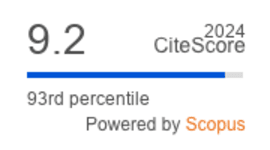Vibrio parahaemolyticus: Exploring its Incidence in Malaysia and the Potential of Streptomyces sp. as an Anti-Vibrio Agent
DOI:
https://doi.org/10.36877/pmmb.a0000334Abstract
As the world recovers from the COVID-19 pandemic, concern remains for future potential outbreaks because of the persisting effects of climate change, including the proliferation of infectious diseases. The frequent isolation of Vibrio parahaemolyticus in the surrounding environment is of concern as it can cause infections in marine animals and transmitted to humans. V. parahaemolyticus is the leading cause of foodborne gastroenteritis worldwide. Malaysia is one of the top seafood consumers and this places us at a higher risk of exposure to V. parahaemolyticus infections. Over the years, this foodborne pathogen has been isolated from various sources in Malaysia, mainly from seafood such as shellfish, shrimps, and fish. To make matters worse, there has been an emergence of antibiotic-resistant V. parahaemolyticus worldwide, which is attributed to the uncontrolled use of antibiotics in aquaculture to prevent and treat vibriosis. Therefore, it is vital to utilize alternatives such as probiotics to control V. parahaemolyticus to prevent further propagation of antibiotic-resistant strains of the bacteria. A potential candidate for probiotics is Streptomyces sp., a class of filamentous, Gram-positive bacteria that produce a variety of bioactive compounds during their life cycle, which can be useful in drug discovery. The bioactive compounds produced by Streptomyces sp. have been proven to have microbiota-modulating and stimulatory effects on the host, enhancing immunity and providing protective effects against V. parahaemolyticus infections. With the application of Streptomyces sp. as probiotics in aquaculture, the efficacy of the available antibiotics can be preserved, and the further spread of antibiotic resistance in the environment can be reduced.
Downloads
Published
How to Cite
Issue
Section
License
Copyright (c) 2023 Ke-Yan Loo, Loh Teng-Hern Tan, Jodi Woan-Fei Law, Priyia Pusparajah, Sunny Hei Wong, Kok-Gan Chan, Learn-Han Lee, Vengadesh Letchumanan

This work is licensed under a Creative Commons Attribution-NonCommercial 4.0 International License.
Author(s) shall retain the copyright of their work and grant the Journal/Publisher right for the first publication with the work simultaneously licensed under:
Creative Commons Attribution-NonCommercial 4.0 International (CC BY-NC 4.0). This license allows for the copying, distribution and transmission of the work, provided the correct attribution of the original creator is stated. Adaptation and remixing are also permitted.

This broad license intends to facilitate free access to, as well as the unrestricted reuse of, original works of all types for non-commercial purposes.
The author(s) permits HH Publisher to publish this article that has not been submitted elsewhere.



.png)

.jpg)
